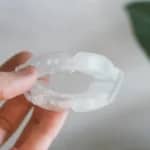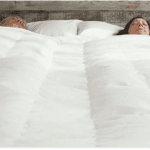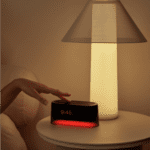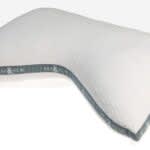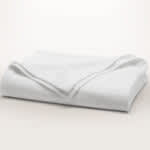Due to its durability, responsiveness, and ventilation, latex is a popular mattress material. The way a latex bed feels and performs depends on the density of each latex layer.
Density measures weight per unit of volume and is described in pounds per cubic foot (PCF). For example, a latex layer that weighs 75 pounds and measures 15 cubic feet has a density of 5 pounds per cubic feet (5 PCF). This formula also applies to other foams, including memory foam and polyfoam.
Mattress shoppers should note the density of different latex components since it directly impacts the feel, performance, and cost of a bed.
How Does Latex Density Compare With Other Foam Types?
Natural latex is made from the liquid sap of rubber trees, giving the material its characteristic bounce and durability. Density and other properties vary depending on the manufacturing method used to make the latex.
While some types of mattresses are made entirely of latex, most incorporate various kinds of foam. Each type has an ideal density range and function in a bed.
Memory foam becomes softer with heat, so its density is more variable compared with latex. Memory foam beds with open-cell constructions tend to be lighter since there are larger air spaces.
Polyfoam density can vary substantially depending on how it’s formulated. Some specialty polyfoams are developed to have properties similar to latex or memory foam. Inexpensive mattresses sometimes rely on low-density polyfoam, which is generally less durable.
Latex, memory foam, and polyfoam are categorized according to low, medium, and high density. Lower-density materials are favored in comfort systems, where they can closely contour the body to relieve pressure buildup. Transitional and core layers commonly use higher-density foams for extra stability and support.
Since each mattress layer has a different purpose, it’s important to consider both the material and density when choosing a mattress.
Density | Latex | Memory Foam | Polyfoam |
|---|---|---|---|
Low Density | Less than 4.3 PCF | Less than 3 PCF | Less than 1.5 PCF |
Medium Density | 4.3 to 5.3 PCF | 3 to 5 PCF | 1.5 to 1.7 PCF |
High Density | More than 5.3 PCF | More than 5 PCF | More than 1.7 PCF |
Let Us Help You Find the Perfect Bed
Answer a few questions to find the right mattress for your unique needs
What Does Latex Density Mean?
The production method used to create latex determines its function in a mattress. Natural latex is manufactured using two main methods: Dunlop and Talalay. With Dunlop latex, the liquid rubber extract is whipped, frothed, and then baked twice. Natural sediment sinks to the bottom during the process, which is why Dunlop is usually denser and firmer. Talalay latex is vacuum-sealed and frozen, which prevents sediment buildup. The extra air pockets make Talalay lighter and more responsive than Dunlop latex.
Synthetic latex is made from petrochemicals and has a similar density and feel to natural latex. Mattresses made with synthetic latex are usually more affordable, though they sometimes have less durability.
Lower-density latex offers more contouring and is commonly used in comfort systems. High-density latex doesn’t yield as much to weight and pressure, making it a better choice for transitional and support layers.
How Latex Density Affects the Layers of Your Mattress
Most latex mattresses contain between two and five layers. The upper comfort layers are typically less dense, allowing sleepers to sink deeper into the mattress. Middle transitional layers generally use medium- to high-density latex to help prevent sagging, while the bottom support layers often include the highest density latex to stabilize the entire mattress.
While this is the most common layout, there are exceptions. For example, some constructions have interchangeable layers that allow sleepers to adjust the firmness and feel of the bed.
How Latex Density Affects Your Mattress Performance
Latex density greatly influences a mattress’ performance and lifespan. While latex is generally resilient, durability typically increases with density.
Density also plays a key role in performance areas that are often important to couples, including bounce and motion isolation. Low-density latex is the most responsive, making it more conducive for sex. Motion isolation, on the other hand, increases with density. High-density latex is therefore the least likely to cause noise and movement disturbances for people sharing a bed.
Mattress Performance | |
|---|---|
Conforming Pressure Relief | While low-density latex permits noticeable sink, the contouring doesn’t offer significant pressure relief. High-density latex alleviates the most pressure buildup since it conforms more closely to the body. However, latex lacks the ability to provide the deep contouring of memory foam. |
Temperature Neutrality | Low-density latex is the most breathable type of latex since the looser structure promotes airflow. While denser latex traps more heat, some companies use small perforations to minimize this tendency. In general, denser latex is still more breathable than other types of foam. |
Weight | Latex is a heavier material, and weight increases relative to density. Latex mattresses typically outweigh models primarily made from memory foam or polyfoam. Weight is generally only a concern when installing or moving your bed, and most latex mattresses weigh between 90 and 125 pounds. |
How Can Latex Density Affect the Firmness of Your Mattress?
Though mattress firmness and latex density are sometimes conflated, they are actually separate considerations. Latex density is an objective value that measures the ratio of weight to volume for each individual layer. Firmness is somewhat subjective and describes the overall feel of a mattress. While there isn’t a universal rating system for mattress firmness, most companies use a 10-point scale, with 1 being the softest and 10 the firmest.
Because mattresses incorporate multiple layers and materials, the relationship between density and firmness isn’t always straightforward. An all-latex bed made with high-density layers feels firmer than an all-latex bed made with less dense components. Most latex beds, however, feature a combination of low- and high-density layers. In this case, firmness is a reflection of the layout and density of each section.





